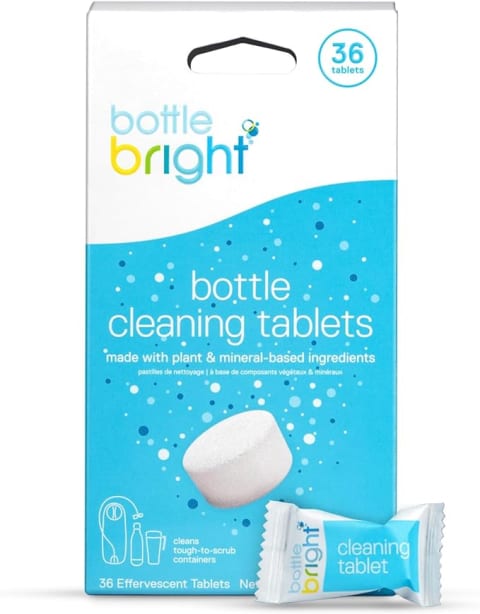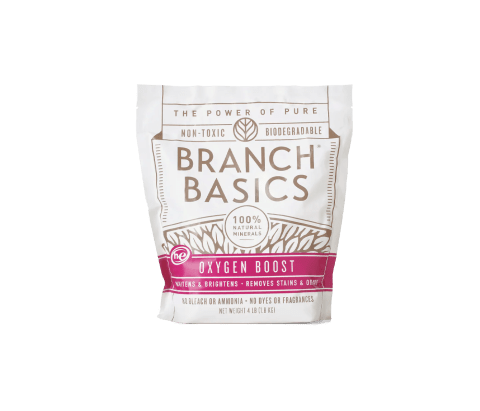Advertisement
The Best Way To Clean Your Water Bottle, From Mold & Toxin Experts


You know the feeling: You glance in your water bottle and your stomach sinks when you realize you haven't washed it in...quite some time. Experts recommend washing water bottles after every use, plus doing deep cleans every once in a while to prevent contaminants from forming in them.
Before you freak out over what you may have accidentally ingested over the years, there's no time like the present to make a change and master a new cleaning routine.
Below, discover exactly how to clean a water bottle, as well as how to clean lids and straws and spot mold.
The need-to-knows:
- Ideally, you'll clean your water bottle after every use: Since reusable bottles can be breeding grounds for mold and bacteria, it's smart to clean yours with a gentle, nontoxic cleaner after every use.
- With bottles, drying is key: Mold forms in damp environments, so you should always wipe down your water bottle with a microfiber cloth and let it air dry completely after each cleaning.
- White vinegar and baking soda can help with deeper cleans: Soaking your bottle with ingredients like baking soda solutions and white vinegar can help lift any stains and odors that accumulate over time.
Why should you clean a water bottle?
According to mold remediator and air quality expert Michael Rubino, dirty water bottles can be a breeding ground for contaminants such as mold and bacteria.
Mold needs water to grow, and these bottles have it in constant supply. If not properly cleaned (and dried!), Rubino explains they can harbor a number of species including Aspergillus1, Stachybotrys2, Cladosporium3, and Alternaria4.
There's also research to show that in rare cases, water bottles can carry pathogens that threaten health. One 2020 study published in MicrobiologyOpen found the antimicrobial-resistant Klebsiella grimontii pathogen (which has been shown to cause cramping and digestive issues5) on a reusable water bottle sent in through a citizen science project called "Swab and Send."
"With the increasing use of reusable water bottles as an alternative to disposables and a strong forecast for growth in this industry over the next decade, this study highlights the need for cleanliness comparable to other reusable culinary items," the study reads.
If you notice your water bottle has developed a clear film or odor, that's a sure sign it needs to be deep cleaned, STAT.
How to clean a water bottle by hand
Chen recommends hand-washing over using a dishwasher since many bottles may get damaged in a machine. Additionally, research indicates that dishwashing plastic bottles in a machine6 can cause microplastics to leach into tap water, making these bottles a potential environmental hazard (even though they may be labeled "dishwasher safe").
- The first step in cleaning a water bottle by hand is to separate all of its parts (straws, lids, etc.).
- Wash the detachable parts by hand using a gentle cleanser, warm water, and a small brush. Vivian Chen, M.D., a nontoxic living expert, recommends using fragrance-free, nontoxic dish soap. (Castile soap is one of mindbodygreen's top picks.) "Never use bleach because it will not lift contaminants from the surface and can lead to unwanted exposure to the harsh chemicals," adds Rubino.
- Add a few drops of soap to the inside of your bottle and wipe it down with warm water and a bottle brush. You can also use cleaning tablets here. If your bottle has any tight nooks and crannies, use your small brush or cleaning toothbrush to get to those. Give the exterior of your bottle a good scrub as well.
- After washing, wipe down the entire surface of the bottle with a microfiber towel.
- Important: Allow all of the parts to air-dry completely before reassembling! "Never let liquid sit for an extended period because some species of mold can grow in 24-48 hours," advises Rubino.
How to clean a water bottle in the dishwasher
If you decide to use the dishwasher, make sure that your water bottle is dishwasher-safe. (Again, Chen advises against putting plastic and silicone items in the dishwasher.) Next, disassemble every piece, placing them in the top rack.
Place any small pieces in a closed-topped basket to prevent them from ending up at the bottom of the machine. "Use the sanitize cycle if available, along with hot water," advises Rubino.
Cleaning lids and straws
- Straws: You'll want to be extra diligent about cleaning your water bottle's built-in straw, as germs can build up in its small opening. Add a drop of your nontoxic cleaner to the top of your straw and run warm water through it, utilizing a straw brush to wipe down the sides. You may want to use a straw cover too, to keep contaminants out.
- Lids: Lids will sometimes have elastic bands on them. Chen recommends removing those first and cleaning the area underneath them well, as that's where mold can often take hold. You can use the same brush you used for your bottle's straw for its lid.
Once again, drying is arguably the most critical step. Thoroughly wipe your lids and straws with a microfiber towel to remove as much moisture as possible and let them air dry before reattaching them to your bottle.
How to deep clean your bottle
According to Rubino, the best way keep your water bottle clean is to wash it using the aforementioned protocol after each and every use. You'll also want to do a deep clean every week or so to remove microscopic particles. You'll definitely want to do this if you notice your water bottle has accumulated an odor or any kind of visible residue. Here's a step-by-step guide:
- Disassemble the water bottle parts.
- Scrub each part with your nontoxic soap. Utilize a bottle brush and, if necessary, a smaller brush to access hard-to-reach areas.
- From there, soak all of the parts in white vinegar overnight.
- The next day, rinse the bottle with soap and water to eliminate any remaining vinegar residue.
- Wipe all parts down with a microfiber towel and allow them to dry completely before reassembling.
Don't forget the brush!
Your cleaning & maintenance toolkit
12.5" Silicone Bottle Brush
This Kitchiny brush cleaner is well-shaped for narrow-neck bottles. Because it's made of silicone, it provides flexibility and doesn't lead to any unwanted scratches.
BUY NOW ($10)

Bottle Bright Bottle Cleaning Tablets
For those who prefer the easy way out (relatable), these biodegradable cleaning tablets require less scrub work than traditional soap. Simply fill your bottle with warm water, add one tablet, let it stand or soak for 15-30 minutes, then empty and rinse.
BUY NOW ($24/36-pack)

5PCS Straw Cover Cap
Keep germs at bay with these cute tumbler toppers. Not only do they keep dust and other particles out, but they are also great for keeping your water in place when hiking, traveling, walking, camping, and more.
BUY NOW ($4/5-pack)

Branch Basics Oxygen Boost
Chen suggests adding this solution, made from a mixture of baking soda and sodium percarbonate (a mineral-based brightener and deodorizer), to your bottle with water and letting it soak to lift any stains quickly. Branch Basics' all-purpose cleaner is great for dishwashing too.
BUY NOW ($22)

When to replace your water bottle
"There's no tried-and-true date for when to replace water bottles," says Rubino. He explains it largely depends on the material: He suggests replacing plastic water bottles after about one year. For metal water bottles, replacement timing is more contingent upon everyday wear and tear; the more worn they become, the sooner they should be replaced.
This is because older and well-worn water bottles provide more opportunities for mold to grow. "Any minuscule crack, crevice, or hole serves as a secluded home for mold growth, bacteria, and viruses," he explains. Given that these areas are challenging to clean, once these particles find their way inside, they're unlikely to leave. The older the bottle, the more pronounced this problem becomes.
How to tell if your bottle has mold
With over 100,000 species of mold in the world, colonies can come in a variety of colors, shapes, and textures. Rubino suggests looking for any green, white, gray, blue, red, black, or brown formations in your bottle. It may appear fuzzy, powdery, velvety, or slimy. "If any type of unidentifiable growth pops up, it's safe to assume there's mold," he says. “If mold is in the bottle, get rid of it."
The mindbodygreen POV
Mold and other contaminants can quickly form on your water bottle if you don't keep up with regular cleaning. Our experts recommend hand-washing your bottle with a nontoxic soap and water after every use (though if yours is dishwasher-safe, you can run it through the machine in a pinch).
Investing in a bottle brush and small straw brush can help make this process a whole lot easier. Be sure to let your bottle dry completely before using it again, and give it a deeper soak with white vinegar as needed.
While reusable water bottles do require some maintenance, that shouldn't keep you from using them! They're still far better for you (and the planet) than single-use plastic bottles, which come with their own contamination concerns7.
—Emma Loewe, mindbodygreen health & sustainability director
FAQ
What is the best way to clean a water bottle?
According to mold remediator Michael Rubino, you should adhere to the manufacturer's instructions on how to clean your water bottle. They know their product best and can provide the most effective cleaning guidelines. That said, for a routine cleaning, most bottles will do well with some dish soap and warm water. Just make sure to disassemble its parts, scrub them down well with a brush, and dry them thoroughly before reassembling and using your bottle.
How do you clean the inside of a water bottle without a brush?
While a brush is the preferred option for removing biofilm, you have alternatives. Chen suggests soaking the bottle with a solution made with Branch Basics Oxygen Boost to lift stains and clean effectively, but be sure to rinse thoroughly afterward. You can also use cleaning tablets, like these ones from Bottle Bright. Alternatively, you can use a long, thin object such as a utensil and wrap a microfiber towel around it. Running this inside the bottle can effectively remove residue.
How do you deep clean a water bottle lid?
Rubino recommends starting by disassembling every part, including the lid tab and gasket if possible. Scrub them with a soft brush and soap, then soak them overnight in white vinegar. Rinse the components the next day, and wash them with mild soap and water to eliminate any remaining vinegar residue. Finally, wipe them with a microfiber towel and allow them to dry completely before reassembling.
The takeaway
You should be cleaning your water bottle with a gentle cleanser after every use and giving it a longer soak in white vinegar as needed. If your bottle is dishwasher safe, that is a good option, although hand-washing is the preferred choice. And if you just don't have time to spend cleaning your bottle, these smart water bottles will do the work for you.
7 Sources
- https://www.ncbi.nlm.nih.gov/pmc/articles/PMC6351985/
- https://www.ncbi.nlm.nih.gov/pmc/articles/PMC145304/
- https://pubmed.ncbi.nlm.nih.gov/15808368/
- https://pubmed.ncbi.nlm.nih.gov/31161546/
- https://pubmed.ncbi.nlm.nih.gov/29205126/
- https://www.ncbi.nlm.nih.gov/pmc/articles/PMC10076389/
- https://www.ncbi.nlm.nih.gov/pmc/articles/PMC8768828/